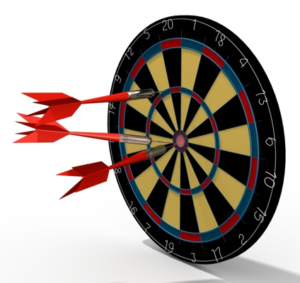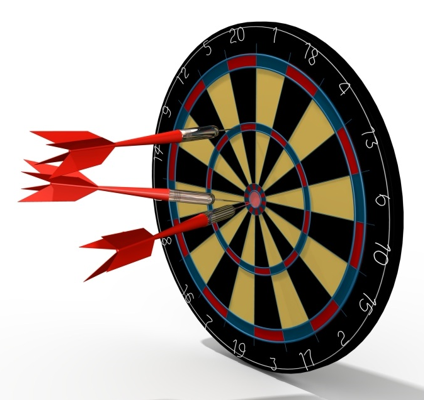Looking to improve your dart game? It all starts with how you set up your dart board.
One of the most important factors to throwing well, in addition to practice, practice, practice, is having your board setup at the proper height and in a good location.
In this article I will be discussing steel tip darts. Some of the measurements will vary for soft tip boards.
The Board
Just like everything in life, dart boards come in a range of quality and price. The better boards, and what I recommend, is a good, high quality bristle board. The bristle board is exactly as it sounds- there are zillions of little bristles all packed together tightly, adhered to a wood backer board, and wrapped in a steel band to keep it all tight and secure. When a dart hits the bristle board, the dart tip securely slides between the bristles, without damaging the dart or the board.
Low-end cheap boards are often made out of paper instead of bristles. The principle works the same, but the paper will wear out much quicker than a good quality bristle board. For a few dollars more, I highly recommend investing in a good quality board- if taken care of, it could last a lifetime!
Installation
Now that you have an awesome quality dart board, what do you do with it? Well, you mount it to your wall, of course… but where and how?
There are a number of environmental factors to consider when mounting a board. The most important will be location.
You will want to choose a non-drafty, well lit, non-high traffic area, with ample room on either side of the board.
By non-drafty I mean avoid areas with overhead heating/cooling ducts or ceiling fans that could affect the flight of your darts. Even the slightest draft can make a noticeable difference in your accuracy.
You will want to ensure that you have an ample ceiling height to provide some comfort room when trying throw for that double twenty.
Side room is equally as important. If you mount a scoreboard (which I highly recommend- chalk, dry erase or grease pencil boards all work great) you will want to leave ample room for your score keeper to stand safely next to the board. A good rule of thumb is two feet on either side of the board.
Lighting is also very important! Nothing is worse than trying to squint to see if a dart is in or out, because the lighting sucks or the darts are casting shadows, etc. I prefer to have a light pointed right on the board (a gimbal light), plus some additional lighting around the board such as additional can lights, table lamps, etc. Multiple light sources help reduce shadows and makes for a more enjoyable playing atmosphere.
Backboards
You may think- hey, I’m a good shot, I don’t need a backboard! Okay, sure thing! But what about your friends, family, or kids that will also be throwing sharp, pointy, steel projectiles at your wall?
Back boards can be made from a wide assortment of materials- from cork squares, to fabric covered fiber board, to a piece of plywood- use your imagination and choose an option that looks good in your room.
Proper Height and Distance
Now that we’ve covered the environmental factors, let’s get to the MOST important part- setting the proper height and distance for the board and toe line.
This is, hands down, the most important consideration. Muscle memory is learned every time a dart is thrown- just like the arch of a basketball being thrown from the foul line or three pointer line- it really is that important!
The dead center of the bullseye should be set exactly 5ft 8inches from the floor surface.
The toe line should be set exactly 7ft 9.25inches from the face of the board.
To triangulate the toe line to the board, measure down from the center of the bull to the toe line- the measurement should be 9ft 7 3/8inches
Marking the Toe Line
Now that you know where the toe line is, how do you mark it?
Use what works best in your situation and flooring surface. You could use piece of duct tape, mark with a marker or chalk, place an area rug, etc. Personally, I use a self-adhesive “The Bull Starts Here” toe line. It’s classy and holds up great! (see the link below my corresponding Youtube video 🙂
Now that we’ve covered nearly everything there is to know about setting up your dart board, now it’s time to get out those darts and get throwing!
Cheers and throw well, my friend!
If you like this article, please consider subscribing. You’ll get a short, non-spammy email notification whenever I post new articles… Thanks, Steve.
[email-subscribers-form id="1"] |


